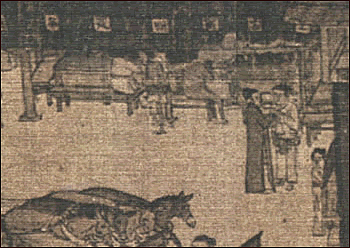The Song Economic Revolution
Commercialization
Farmers in Song China did not aim at self-sufficiency. They had found that producing for the market made possible a better life. Farmers sold their surpluses in nearby markets and bought charcoal, tea, oil, and wine. Some of the products on sale in the city depicted in the scroll would have come from nearby farms, but others came from far away. In many places, farmers specialized in commercial crops, such as sugar, oranges, cotton, silk, and tea.
Merchants in the cities became progressively more specialized and organized. They set up partnerships and joint stock companies, with a separation between owners (shareholders) and managers. In large cities merchants were organized into guilds according to the type of product they sold. Guilds arranged sales from wholesalers to shop owners and periodically set prices. When the government wanted to requisition supplies or assess taxes, it dealt with the guild heads.
Transport
As the economy became more commercialized, the need for transport grew. In the scroll, we see goods carried in backpacks, larger wheelbarrows, wagons, and on donkeys and camels. Camels carried goods from Inner Asia or further west across large desserts.
Water transport, however, has always been far cheaper than going over land. The South, with its many rivers and waterways, had an advantage in this respect, but northern cities, too, were served by water transport, often canals. The Grand Canal linked the North to the Yangzi River region. One section of the Beijing qingming scroll shows men unloading bales of grain from a river boat, as a merchant, seated, directs them.
According to Marco Polo
Marco Polo was astounded at the boat traffic on the Yangzi River. He claimed to have seen no fewer than 15,000 vessels at one city on the river, and said other towns had even more:
You must know that when you leave the city of Yanju, after going 15 miles south-east, you come to a city called and trade. ... And you must know that this city stands on the greatest river in the world, the name of which is KIAN [Yangzi]. ... This it is that brings so much trade to the city we are speaking of; for on the waters of that river merchandize is perpetually coming and going, from and to the various parts of the world, enriching the city, and bringing a great revenue to the Great Kaan.
And I assure you this river flows so far and traverses so many countries and cities that in good sooth there pass and repass on its waters a great number of vessels, and more wealth and merchandize than on all the rivers and all the seas of Christendom put together! It seems indeed more like a Sea than a River. Messer Marco Polo said that he once beheld at that city 15,000 vessels at one time. And you may judge, if this city, of no great size, has such a number, how many must there be altogether, considering that on the banks of this river there are more than sixteen provinces and more than 200 great cities, besides towns and villages, all possessing vessels? (1)
More about Marco Polo
• Key
Figures in Mongol History: Marco Polo [Asia
for Educators]
With excerpts from Marco Polo’s account of life
at Khubilai Khan’s court.
• Marco
Polo and His Travels [Silk Road Foundation]
A
brief account of Marco Polo’s life, travels, and writings.
• Marco
Polo [National Geographic]
A two-part
series published in May and June 2001. Full access to articles requires
a subscription.
![]()
Notes
(1) Marco Polo and Rustichello of Pisa, “Book Second, Part III, Chapter LXXI: Concerning the City of Sinju and the Great River Kian,” in The Book of Ser Marco Polo: The Venetian Concerning Kingdoms and Marvels of the East, translated and edited by Colonel Sir Henry Yule, Volume 2 (London: John Murray, 1903). This book is in the public domain and can be read online at The Internet Archive. Chapter LXXI begins on page 189 of this online text.
 Customers at a shop selling cloth, Beijing qingming scroll
Customers at a shop selling cloth, Beijing qingming scroll